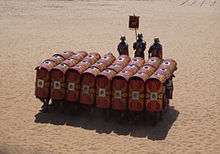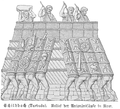Testudo formation
 | ||||
| Part of a series on the | ||||
| Military of ancient Rome | ||||
|---|---|---|---|---|
| Structural history | ||||
|
||||
| Campaign history | ||||
| Technological history | ||||
|
||||
| Political history | ||||
|
|
||||
| Strategy and tactics | ||||
|
||||
|
| ||||
In Ancient Roman warfare, the testudo or tortoise formation was a formation used commonly by the Roman Legions during battles, particularly sieges. Testudo is the Latin word for "tortoise". The Greek term for this formation is "chelone" and during the Byzantine era, it seems to have evolved to what military manuals of the era call the "foulkon".
Formation

In the testudo formation, the men would align their shields to form a packed formation covered with shields on the front and top. The first row of men, possibly excluding the men on the flanks, would hold their shields from about the height of their shins to their eyes, so as to cover the formation's front. The shields would be held in such a way that they presented a shield wall to all sides. The men in the back ranks would place their shields over their heads to protect the formation from above, balancing the shields on their helmets, overlapping them. If necessary, the legionaries on the sides and rear of the formation could stand sideways or backwards with shields held as the front rows, so as to protect the formation's sides and rear; this made the formation slow and they covered very little ground.
Plutarch describes this formation as used by Mark Antony during his invasion of Parthia in 36 BC:
- "Then the shield-bearers wheeled round and enclosed the light-armed troops within their ranks, dropped down to one knee, and held their shields out as a defensive barrier. The men behind them held their shields over the heads of the first rank, while the third rank did the same for the second rank. The resulting shape, which is a remarkable sight, looks very like a roof, and is the surest protection against arrows, which just glance off it."[1]
Cassius Dio writes about the testudo when describing the campaign of Mark Antony in 36 BC:
- "This testudo and the way in which it is formed are as follows. The Baggage animals, the light-armed troops, and the cavalry are placed in the center of the army. The heavy-armed troops who use the oblong, curved, and cylindrical shields are drawn up around the outside, making a rectangular figure, and, facing outward and holding their arms at the ready, they enclose the rest. The others who have flat shields, form a compact body in the center and raise their shields over the heads of all the others, so that nothing but shields can be seen in every part of the phalanx alike and all the men by the density of the formation are under shelter from missiles. Indeed, it is so marvelously strong that men can walk upon it and whenever they come to a narrow ravine, even horses and vehicles can be driven over it."
Tactical analysis
The testudo was used to protect soldiers from all types of missiles. It could be formed by immobile troops and troops on the march. The primary drawback to the formation was that, because of its density, the men found it more difficult to fight in hand-to-hand combat and because the men were required to move in unison, speed was sacrificed. As "foulkon", it played a great role in the tactics employed by the Byzantines against their eastern enemies.
The testudo was not invincible, as Cassius Dio also gives an account of a Roman shield array being defeated by Parthian cataphracts and horse archers at the Battle of Carrhae:
For if [the legionaries] decided to lock shields for the purpose of avoiding the arrows by the closeness of their array, the [cataphracts] were upon them with a rush, striking down some, and at least scattering the others; and if they extended their rank to avoid this, they would be struck with the arrows.
Modern usage
During the Euromaidan protests in Kiev, Ukraine in 2014 the Berkut riot police used the testudo tactic to protect themselves.[2]
Gallery
-

-

Rendered on Trajan's Column
-

-
See also
References
- ↑ Plutarch: Antony, c. 45, quoted in Plutarch, Roman Lives, ed. Robin Waterfield ISBN 978-0-19-282502-5
- ↑ The Battle For Ukraine Is Being Fought Using Ancient Military Tactics, Geoffrey Ingersoll, Business Insider, January 22, 2014
- Dio Cassius, Roman History Book 49, 30, ed. Loeb Classical Library ISBN 0-674-99091-9
Bibliography
- Cowan, Ross, Roman Battle Tactics 109BC - AD313 (Osprey 2007)
- Rance, Philip, "The Fulcum, the Late Roman and Byzantine Testudo: the Germanization of Roman Infantry Tactics?" in Greek, Roman and Byzantine Studies 44 (2004) pp. 265–326: http://www.duke.edu/web/classics/grbs/FTexts/44/Rance2.pdf.
- Plutarch, Roman Lives, ed. Robin Waterfield ISBN 978-0-19-282502-5
- Dio Cassius, Roman History Book 49, 30 ed. Loeb Classical Library ISBN 0-674-99091-9
| Wikimedia Commons has media related to Testudo formation. |